Theory and Analysis:List of Common Misconceptions
A tentative list.
Please also refer to the FAQ section on Evaotaku. See also: Statements by Evangelion Staff
This generally refers to the original series or the franchise in general. For questions specific to the Rebuilds, see:
NGE is religious propaganda
The religious symbolism in NGE is actually not used in any sort of religiously meaningful fashion. According to Evangelion Assistant Director Kazuya Tsurumaki:
"There are a lot of giant robot shows in Japan, and we did want our story to have a religious theme to help distinguish us. Because Christianity is an uncommon religion in Japan we thought it would be mysterious. None of the staff who worked on Eva are Christians. There is no actual Christian meaning to the show, we just thought the visual symbols of Christianity look cool. If we had known the show would get distributed in the US and Europe we might have rethought that choice."' - Kazuya Tsurumaki: Q&A from "Amusing Himself to Death"
Here's an old essay from 2001 of someone getting it wrong: "However, it is revealed at the end of the series that the Angels are actually failed attempts in the Creation (i.e., the Biblical Creation) that preceded mankind". Early inaccurate translations of the show may have contributed to this confusion.
LCL means "Link Connect Liquid"
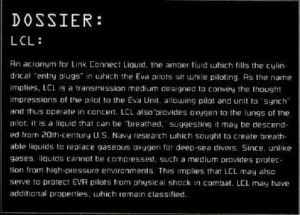
It is unknown what the initials "LCL" stand for within the anime series, but we do know what they don't mean. According to the Death and Rebirth theatrical program (special edition):
Incidentally, the widely circulated idea that L.C.L is the abbreviation of "Link Connected Liquid" is incorrect.
Nowhere does it say what it means, although Evangelion Chronicle suggests one of the Ls stands for "Lilith".
In Sadamoto's Manga version, LCL is said to stand for Link Connect Liquid, written in the Dossier before a chapter starts. This is apparently one of the instances of the manga being different just for the sake of it, something Sadamoto has wished for in some interviews.
Gainax ran out of money and/or was censored
Easily the most enduring myth around the production of Evangelion is the notion that the series' ending came about as a result of a lack of money and/or censorship by the network. In reality, Evangelion's troubled production was mostly a result of poor planning, changing decisions and running out of time. Restrictions set by the producers and the network were minimal, the only significant instance being the death of Toji being changed into him losing his limbs. There are also other factors that influenced production, like the Aum Shinrikyo attacks in 1995. This is also one of the reasons why the series was not released before or along with the promotional manga as initially planned.
The lyrics of A Cruel Angel's Thesis have messages about the plot
A rather natural assumption asserts that Evangelion's theme song, A Cruel Angel's Thesis, has a hidden meaning for the show and helps illuminate plot points. In fact, this song was written with very little involvement from the show's creators, as the producers did not allow the anime staff to even meet the music staff. The songwriter, Neko Oikawa had no prior knowledge of the show, and simply skimmed through a proposal of the show (possibly Neon Genesis Evangelion Proposal) and watched two unfinished episodes on fast-forward, only serving to broadly "fit" the anime after the fact (Oikawa's interviews are referenced in the main article on A Cruel Angel's Thesis). Anno originally wanted to use an excerpt from Borodin's Polovtsian Dances in the opening, but the producers did not approve of this and instead decided to use a J-Pop song, which eventually resulted in the creation of this song. The opening sequence was not finished yet either during production of Episode 01. It is purely promotional.
It's worth noting that Komm, süsser Tod and Everything You've Ever Dreamed were written by Anno (though later adapted into English) and can be taken to be more authoritative than ACAT.
Evangelion is a small franchise
This one is a bit curious, and mostly seen in the English speaking fandom, by virtue of the problematic and messy history of the availability of Evangelion in English speaking markets leads many to assume Evangelion, as a franchise, is a small, underground cult classsic. This claim however disregards, or simply isn't aware absolutely gigantic influence Eva had on Japanese culture and media, often being cited as a redefining work for the entire anime industry and beyond, personified by the gargantuan popularity Rei, the "Premium Girl", enjoyed for years, as well as the hundreds of characters inspired by her. Evangelion is, in fact, a pop culture phenomenon in Japan and even attained relative mainstream status in a good portion of the West. Another effect of this misconception is surprise at the variety and perceived shamelesness of Evangelion merchandise nowadays, when in fact that already existed in enormous amounts even before the series was finished airing. E-Mono is an example, a 143-page merchandise catalogue from 1997.
Part of it is attributable to the earlier statements and general conduct of ADV Films, the first localizer of Evangelion back in the 1990s, as at one time their staff had major influence in English fandom, and later other American anime companies like Funimationa and Crunchyroll, and even media coverage in the Anglosphere. These often retain a strong "fannish" component to this day, leading to inconsistent levels of quality and professionalism, so they often treat properties such as Eva as something a lot more niche and underground than it really is, reflecting their own experiences. The Spanish, Portuguese, Italian and French-speaking fandoms are a good counterexample, as in all of those countries anime had already reached mainstream appeal years before Evangelion was first aired, even during the 1980s, and Evangelion was shown on public television in the 1990s. This means that Evangelion was, in many aspects, simply one of many cartoons - though it of course atained notoriety of its own. This also means they have more access to spin-offs and supplementary material in their markets, fully translated, often to higher standards than whatever was available for English-speaking fans, where anime would remain a relatively niche interest and subculture until the 2010s. These spin-offs and the Evangelion manga also enjoy significant popularity in those countries on their own, particularly Angelic Days and Shinji Ikari Raising Project. Meanwhile, the English speaking market suffered from the limited availability of ADV's early VHS releases and relied mostly on bootlegs and fansubs. This is why to this very day several illegal streaming sites still utilize fansubs which many believe to be official translations. ADV would later release two DVD collections in 2001 and 2003, Perfect Collection and Platinum Collection. Each one has significant differences compared to the others. Though the Platinum Collection release is generally good, it still has some problems - the dub is the same, and it'd come years later and is still of limited availability, as its fairly limited production was then cut short by ADV going defunct in 2009. This also leads to fans having multiple official (and fanmade) localizations to base themselves on - though this has improved after the Netflix release in 2019.
Australia is actually an exception, having actually gotten a public TV screening of Eva many years before Evangelion's initial, limited (though too small a market too make an impact versus the US, UK and Canada) and heavily edited screening in Toonami in the US in 2003. A later, unedited airing in Adult Swim in 2005 brought in a new wave of English-speaking fans, particularly Americans.
The manga is the original or first version of the story, or timeline
Though this is often the case for many manga later adapted as anime, Evangelion was in fact originally created as an anime series by Hideaki Anno, and the manga was instead created as a supplemental designed to promote the TV series by character designer Yoshiyuki Sadamoto. The series however had a delayed first airing, but NGE's popularity lead to the manga continuing. Despite cutting most of the series' storyline, the manga was finished in 2013, thanks to a very inconsistent schedule and multiple years-long hiatuses. Sadamoto, the author of the manga and character designer for the series (no involvement as a writer) has repeatedly stated the manga is his separate project. Sadamoto has also stated he made the manga entirely on his own, without consulting anyone, in contrast to the anime's more collaborative production, and that all differences were decided by him. He referred to the Evagelion manga as "a reworking of a pre-existing work." and also asks fans not to use it to inform the anime or the Rebuild movies. In particular, he even says the Mari bonus chapter at the end of the manga was just fanservice.
Mari or Kaworu is a timeline traveller
Mentioned above as well as in other items: Sadamoto explains that he added Mari in and Anno has had no involvement or approved anything in the manga and he has just added the Mari bonus chapter as fanservice. This is mentioned in other instances as well.
As mentioned in other sections, this also does not apply because of the spin-offs non-canonicity according to their own creators, as well as the myth of the manga being the "original" story - see above. In Kaworu's case, there are only two spin-offs in the entire franchise that so much as play with the idea of timelines or multiple universes at all, Campus Apocalypse and Angelic Days. Using them as an argument also omits Kaworu's relatively low importance and presence in those spin-offs: the former is a "paranormal" story centered on Rei/Shinji only using a "Yggdrasil" as a vague Norse reference plot point of holding the "fabric of reality" that is however completely extraneous to the rest of the entire Evangelion franchise, and the latter is a romantic comedy that focuses on Asuka/Shinji. Kaworu even offers Shinji to stay in a sort of pocket dimension with him as children forever, and Shinji refuses. Kaworu even disappears from reality after that instance, and in the following chapter is shown helping Gendo and Yui get together in the past, as well as briefly wishing well for Shinji and Asuka's relationship in the future. This is the only spin-off that ever has any character traveling in time. In Shinji Ikari Raising Project, Kaworu is also present only for a very short period as a "spy" for Seele and is used as comic relief in this ecchi comedy story, only to then completely disappear from the story for the remaining 10+ years of publication. Mana Kirishima, an extracanonical character from the Girlfriend of Steel videogame, has the exact same treatment but a longer presence. Overall, Kaworu is not even present in the majority of spin-offs and games, and when he is it's usually only to fight him. As mentioned elsewhere, the nature of these spin-offs is purely commercial and they are sprinkled with teasing and fanservice for fans of all characters and pairings, and Asuka and Rei are in fact the rule, not the exception. You can also find more about it here.
Do note this might not apply to the "Sequel Theory" concerning the anime and Rebuilds alone, depending on whatever happens in the final movie. This also does not leave out the possibility this might apply in some sense, even a self-contained one within the Rebuilds alone, to Rei as Quantum Rei, which at least in the series actually does have a non-linear existence across space-time.
The manga, spin-offs and/or video games are canon or complementary to the series
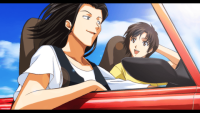 |
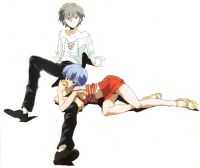 |
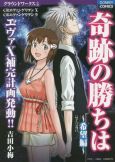
|
|
As examples, here is the scenario from Neon Genesis Evangelion 2 in which Maya and Aoba form a relationship; official art with Rei and Kaworu, from the Die Sterne artbook, and an official spin-off with Kaworu dating an original female character. | ||
See also: Theory and Analysis:What Is Canon?
See above. In The Notenki Memoirs, it's even commented just how indifferent Anno was to derivative material. In the 2021 NHK documentary, Megumi Ogata also states that Evangelion not written by Anno isn't "real Evangelion". This of course also applies to merchandise. Hayashibara also treats them as simply fanservice and not "Eva":
"It's been like that for a while now, but for better or worse, there have been various "Evas" between movies, and as for Rei, her flesh and blood voice hasn't been interrupted for the past eight years. There have been various collaborations such as pachinko and video games. However, these are just recreations of famous lines from the past, or the incorporation of lines from the past into current games so that people who enjoy the games can remember the past. Only "Eva," Anno's new creation, is ultimately the present, the future, and the new work. When I touch it, it has a juiciness and freshness like a freshly peeled fruit, which makes me nervous but also happy. First of all, I didn't expect another Rei [Ayanami Rei (tentative name)] to be so talkative. I've said this many times before, but when Ayanami Rei blew herself up in the TV anime series, she was over for me. I felt as if I had said goodbye to her, but then the Rei appeared again in the form of "maybe the third one," and after that, every time she appeared in one of the many Raising Projects or games, I would think that this was the fifth, sixth, seventh, or eighth Rei, and I would try to make sense of her in order to make my I've been working with her, making sense of her to make it easier for me to do my job." - Megumi Hayashibara, 3.0+1.0 booklet interview
First Impact killed the dinosaurs
First Impact was never depicted or directly referred to on-screen. This has led several fans upon first glance to incorrectly assume that because the "Second Impact" was supposedly a meteorite collision, the "First Impact" was thus the more well known asteroid impact which caused the mass-extinction of the dinosaurs at the end of the Cretaceous period, 65 million years ago.
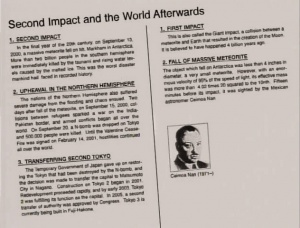
However, First Impact (aka "Giant Impact") was actually the collision of a giant spherical object, designated the "Black Moon", into Earth approximately 4 billion years ago. As a result of the impact, huge amounts of debris, including the Black Moon's rocky exterior, were thrown into orbit, eventually coalescing into Earth's satellite, the Moon. This was made clear in the Classified Information. The "meteorite" theory in the above textbook page is a cover story, and is part of the effort to also blame Second Impact on a meteor.
"Barons of Hell"
Almost from the beginning of Eva fandom, there has been an internet rumor that the Evangelions are based upon Biblical entities called "The Barons of Hell". There are two problems with this theory:
One is that there is no such thing as a "Baron of Hell" mentioned in the Bible or in any other Judeo-Christian source; extensive searches for the term have turned up only references to Eva and the video game Doom. Some sources claim that the Barons are the same thing as the "Four Horsemen of the Apocalypse", but the descriptions given to the Barons don't match up to the Horsemen.
The other problem is that we know exactly what the Evangelions are based upon. Evas were fundamentally based upon the oni (commonly translated as “demon” or “ogre”, but actually a specific type of Japanese monster). Says Anno himself (in an interview published in Aerial Magazine):
There's a monster in Japan called the Oni; it has two horns sticking out of its head and the overall image of the Eva is based on that. I also wanted to give the impression that beneath this ‘robot monster’ image is not so much a robot, but a giant human. - Anno's Roundtable discussion
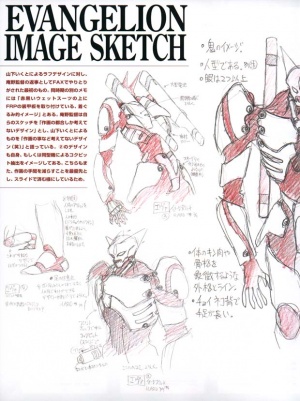
An early sketch Anno did of an Eva clearly betrays their oni roots. Working from this basic premise, and corresponding with Anno along the way, Ikuto Yamashita developed the Evas as we know them (with the exception of EoE's “harpies”).
Kids born after 2I are soulless
A bizarre idea used to explain the drop in the birth rate after Second Impact, and why only kids born after Second Impact can synch with the Evangelions. This theory has no basis whatsoever as Ritsuko explicitly states in Episode 20 that Shinji, born after Second Impact, has a soul.
Only children born after Second Impact can pilot Evas
An idea that for some reason is still present even in synopses and guides for Evangelion on multiple sites, the idea here is that Shinji, Asuka, Rei and Toji are designated pilots because specifically because they are born after Second Impact. Though this is not strictly incorrect, this leads the reader to assume that the post-2I world has some sort of effect in children born after that event, but there is no evidence or even any allusion present in the show whatsoever, since the actual reason they are selected as pilots is instead because of the link they share with their mother's souls embedded in the Evas. It is implied that Hikari, Toji and Kensuke have all lost their mothers as well, and this presumably extends to the whole of Class 2A - some speculate that Nerv has some sort of "soul bank" with each pilot candidate's mother's soul.
Naturally, Rei and Kaworu are an exception since they have a direct link, possessing part of the souls of Lilith and Adam respectively. It's worth mentioning that their birth dates are also not at all important or even mentioned in the actual show and merely are one of the instances of it being retroactively imprinted using their voice actors' birthdates, as is common anime industry practice.
Spear of Longinus is the actual holy relic (that just somehow got big)
This is a product of putting too much stock in NGE's religious references. The Spear was actually excavated in Antarctica along with Adam, who was found impaled upon it. According to the Classified Information, each Source of Life is accompanied by a Spear that has a will of its own and can immobilize a Seed for going against its mission. Thus, the Spear of Longinus is billions of years old—not made by a Roman blacksmith—which impaled Adam for committing an unspecified offense.
A.T. Field is a real-life psychology term
Since the very earliest days of Evangelion analysis, there has been a rumor that A.T. Field is a genuine psychological term that describes the barrier that separates autism patients from the world around them. However, extensive searching for online Psychology researches and forums has failed to find any use of the term other than in reference to NGE. Further research by those in the field has proven that "Absolute Terror" or similar terminology is simply not recognized in academia. Therefore, this rumor is false and has been conclusively proven so.
Some examples of fan-pages propagating this rumor: 1 2
Rei and/or Kaworu are a representation of Shinji's unconscious
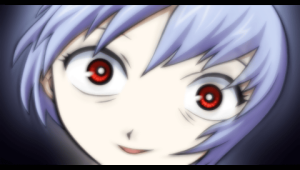
An example commonly cited when discussing the conceptualization of Eva, stemming from a mistranslation or misreporting of an Anno interview. This interview was published in the November 1996 issue of Newtype Magazine. Anno says that he identifies with Shinji in both a conscious and unconscious manner (also mentioned here), and he, Asuka and Misato are close to himself, while Rei is Anno's "deepest part" and Kaworu his Jungian shadow, not Shinji's. Naturally, Shinji being mentioned as one of the items makes this claim even shakier. This is a rather long interview containing several famous excerpts but hasn't been fully translated, though several other excerpts are available on gwern's source anthology, and the relevant section has been summarized in the forums.
Referring to his original intention, Anno notes also notes:
The plan was that the ‘unconscious Shinji-kun’ would be Ayanami Rei, the Shinji-kun who appears on the surface would be Ikari Shinji, and the ‘ideal Shinji-kun’ would be Nagisa Kaworu-kun. [Kaworu was] supposed to be an ideal male but when I tried putting him together he was just a strange fellow (laughs). That was something of a lack of capability on my part. - Interview ‘with a member of Waseda University for the purpose of “character study.”’
Anno: [He is an ideal Shinji] Because he is a character who has been cleared of all of Shinji's complexes. Well, that part doesn't come through clearly due to shortcomings in my depiction. - 1st June interview.
The problem here is that Anno never makes it clear if he held on to the idea of Rei being an unconscious Shinji - in other interviews he echoes having had problems with characterizing Rei as she's part of his unconscious and somewhat hard to connect with. It Is much more clear with Kaworu, nonetheless.
Anno deliberately modelled characters on certain people
Another common claim. Although VAs like Yuko Miyamura and Yuriko Yamaguchi (Ritsuko) have influenced characterization to varying degrees, Anno is quite adamant about characters being first and foremost based on him. Some of the common claim include:
- Misato is claimed to be based on Noriko Hidaka, voice actress of Jean from Anno's previous work, Nadia. This claim comes from a widely disproven slander document, the Kaibunsho:
When the TV version of “Nadia” launched, Anno confessed his feelings to Hidaka Noriko. This is a famous story in the industry. Apparently Anno told her that he “looked at her not as an object of adoration/longing, but as a serious love interest!” (ROTFL!)" [sic] - Kaworu being modeled on a real person or experience, but this has been denied long ago by both Anno and Sadamoto:
"What about whatever research you’d done?
Anno:There was none."
[...]"Telling someone or being told by someone, “Your heart is like glass,”—did anything like that actually happen to you?
Anno: Nope, nothing like that." - JUNE interview
—When you designed Kaworu, did you base his looks on someone?
Huh? No. But, as the last Angel, if I make his profile a combined form the of people that the past Angels made a contact with——what about something like this——I have this concept. That is why some parts of Kaworu look like Shinji, some parts look like Rei, some parts look like Asuka. - All About Kaworu Nagisa interview
Neither is this ever even alluded to in multiple Sadamoto interviews detailing his design, or sources like the Newtype Film Books or Evangelion Chronicle. - Gendo on Anno's own father seems unlikely considering Anno was quite open about having a good relationship with him. Instead, Gendo is described as representing the "pressure of society":
"Ikari Gendo is not exactly popular in Japan. Many think that he is too stern with Shinji and that he generally exudes the aura of a hard, traditional, strict father. Gendo was meant to be a strong father who should have a positive influence on Shinji so that he could grow to be more confident and adult-like. Many modern fathers in Japan are “mollycoddled” which was another reason to make Ikari Gendo into a strong father." – FUNime interview with Kazuya Tsurumaki, English translation by Kendrix
In fact, Anno's father seemed to have influenced Toji of all people:
"My father has only one leg. While working at a lumber mill he had his left leg seriously injured with an electric saw. He was 16 years old at the time. He wears an artificial leg below the thigh. He has trouble walking, so he used to stay at home.
But there is no doubt that I have been influened by father's physical handicap. I cannot love anything perfect."- Disability Shapes Taste for the Imperfect
See Character Name Origins for naming comments by Anno himself on designing the characters.
Eva-00 has the soul of Naoko Akagi or none at all
The most accepted theory is Rei I's soul, being in turn a portion of Lilith's own soul. Please visit Eva-00's soul for more information.
Someone we know killed Kaji/Misato killed Kaji
This is one of the most famous early misconceptions. Usually, the piece of evidence used is the original cut present in the On-Air version of Episode 21. This theory shocked Anno so much at the time that he'd later rectify it in the Director's Cut version of Episode 21 by changing the previous "evidence" for this, a shot of her room's door with her name on it, which was changed to just a shot of her apartment complex. This is one of the few cases of a straight-up retcon in Evangelion.
This was controversial enough to be addressed by Newtype at the time: "While a lot of fans think that it was done by Misato, Director Anno raised the possibility that it could have been done by Japan government or Seele agent". The film-book also states that the killer was not a main character.
…Who killed Kaji? What’s your version of it?
This is a question that many Japanese fans also wonder about. Kaji wanted to investigate a deeper part of NERV (SEELE) and learn of its secrets. He was tricked by one of his informants and then killed. It wasn’t Misato or Ritsuko. - Tsurumaki, FUNime March 2002 interview
Rei and Kaworu are actual albinos
Actual albinos don't have light blue hair! Albinos cannot walk outside without protection, otherwise they would suffer severe sunburn, and most have very poor eyesight. On the contrary, Kaworu's eyesight appears to be exceptional (such as his noticing Misato in the Episode 24 director's cut lake scene). It is worth noting that Ritsuko's complexion is only slightly darker than Rei's, although she's obviously not an albino.
Kaworu was not a clone, and had a "natural" human appearence
This theory posits that Kaworu's human appearance was naturally occurring like those of the other Angel's or even chosen by him in order to enter Nerv. In fact, he was created using human DNA and an Angel's soul, being the Seed of Life Adam, just like Rei was created with Yui's DNA and Lilith's soul.
Episode 21':
Man E: "The contact experiment with the donor is scheduled for the 13th of next month. There will be time for any adjustments."
(later) Woman B: "The genes that dived into Adam have already undergone physical fusion!"
Episode 24':
SEELE A (speaking to Kaworu): [Adam's] salvaged soul exists only within you.
Neon Genesis Evangelion 2. Classified Information: Adam.:
"At the time of Second Impact, [Adam's] body was torn apart, and its soul flew off somewhere as a result. Adam's soul was later recovered by Seele and incarnated.", whom they may have recovered in embryonic form in Antarctica.
Kaworu's human DNA donor, however, is unknown. See: Theory and Analysis:Identity of Kaworu's Donor
Toji not only loses his leg, but his arm as well
While Toji's left leg is plainly missing when he's on the hospital bed, it's not certain to tell if his left arm is, as well. However, both Toji's arms are seen as he is being hauled out of the entry plug. The original storyboards for The End of Evangelion contain a scene showing Toji playing wheelchair basketball with Kensuke, where he clearly has both arms, eliminating the possibility that one of his arms was amputated.
Naoko's Brain in Magi
Or any other brain for that matter. This is due to the brain-like object Ritsuko reveals when she cuts into the Magi in episode 13. It is clearly stated that the Magi merely have personality imprints of Naoko Akagi - herself as a mother, scientist, and woman. The computers are also far too large to be actual human brains.
Naoko's Soul in Magi
Likely originated due to the fact that the Evas have the souls of their pilots' mothers. There's also the issue of Caspar 'betraying' Ritsuko in The End of Evangelion, but machines cannot be implanted with souls (and hence can't project A.T. Fields, as was clear in Episode 07).
Keel is the Wandering Jew
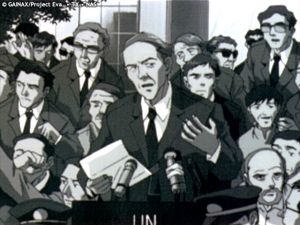
One of the most bizarre myths about Evangelion. There is an old and racist story that claims that an onlooker at Christ's crucifixion spat upon him, and was punished by receiving the curse of immortality. He thus became the "wandering Jew", never able to make permanent friends or stay in one place, lest people notice his never-aging nature. The theory goes that Keel's motivation in bringing about Instrumentality would at long last allow him to die.
There are, at the very least, two huge problems with this notion. One being there's absolutely nothing in the series to indicate this is Keel's motivation. The other is that when Keel appears in a flashback in episode 21, he is visibly younger than in the series' present, and as has been noted, the Wandering Jew is supposed to be ageless.
The Dummy Plug Plant is the Chamber of Guf
The Chamber of Guf is mentioned by Ritsuko in episode 23 when she, Misato, and Shinji are down in the Dummy Plug Plant. This comment likely lead people to believe the two were synonymous. Please look here for an explanation of Guf within NGE.
Adam was impaled on the Spear of Longinus by Lilith
The "Duel of the Seeds" idea was made up to explain why one Seed would be skewered by the Spear of Longinus and placed in suspended animation while the other would be free to spread life on Earth. The interaction between Rei and Kaworu was interpreted to mean that both of them (as Lilith and Adam respectively) had interacted previously. This idea was disproved when the Classified Information files revealed that each Seed was sent with its own Spear, and that Lilith's Spear was either lost or destroyed during First Impact. Adam was placed in suspended animation by its own Spear, which was used to impale Lilith later on.
Death's string quartet scenes don't take place in the actual timeline
While until lately the predominant idea was that the string quartet scenes are simply artistic linking devices that don't truly take place in the series timeline, a more logical idea instead pertains that they actually do-it's just that the characters featured there aren't Shinji, Asuka, Rei and Kaworu, but rather characters who look like, sound like and have some basic characteristic similarities to them. Considering the heavy focus put on giving a concrete time and place for the scenes (an illogical thing for a surrealistic scene), it seems logical to assume this is the time and place when these scenes transpired in the timeline, instead of merely more confusing abstraction. Moreover, none of the musicians ever have their entire faces in a frame. Beyond that, there are also no links made between the musicians and the four pilots unlike other times in Death when there is a clear connection made between a character whenever a timejump is made. Furthermore, the official book The Evangelion Chronicle: Side B explicitly calls the musicians different characters.
A line from the book reads as following: "Before the Third Angel attacked, a quartet of boys and girls gathered in the school auditorium of the Third Middle School in Tokyo-2 to perform "Pachelbel's Canon". These young musicians bore an uncanny resemblance to the four Children upon whom the world's fate would come to rest." So it is made absolutely clear that the instrument players are not the main characters.
Additionally, from the Refrain of Evangelion booklet: 1. Suiten for Violoncello solo Nr. 1 G-dur, BWV. 1007 1. Vorspier
This is the opening for EVANGELION: DEATH and an introductory part of Bach’s unaccompanied cello suite #1 played by a boy who looked just like Shinji.
See also: Death's string quartet scenes
Death threats, and "Anno's Revenge"
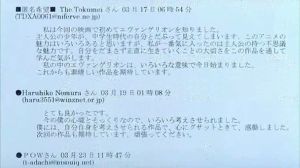
Main article: End of Evangelion Death Threats
Many are lead to believe, one way or another, that The End of Evangelion was Anno's revenge against the fans for the negative response received from the ending of the TV series.
Some say it is because Anno brutally killed off all of the main characters; however, this isn't anything new in the world of anime. Most notably, Yoshiyuki Tomino's Space Runaway Ideon, where not just all the main characters are killed off, even children are brutally massacred. Even though Ideon may be one of Anno's biggest inspirations for Evangelion, the End of Evangelion was closer to the planned ending to the TV series Anno's October 2013 interview. Some of the footage used in the TV series ending (corpses of Misato and Ritsuko) indicates that, even before the TV series ended, Anno had planned on killing these characters.
Some say it is because of scenes such as Shinji visiting the sedated Asuka in her hospital room. Although slightly out-of-left-field compared to the ending of the TV series, this scene does serve its purposes. Most importantly, it shows that Shinji has hit the lowest of lows, and secondly, it's referenced later in the movie when Asuka says "Idiot! I know about your jerk-off fantasies of me. Do it again like usual... I'll even stand here and watch."
A subjective argument for Anno's revenge is the cinematic and narrative mindfuck that takes up most of the 2nd half of End of Evangelion. A subjective retort could be, "What about the end of the TV series?". As far as a non-subjective response, films have been known to use clashing motifs, non-linear storytelling, and highly symbolic/obscure imagery, and the End of Evangelion isn't the first to use all three. Also, from an interpretive standpoint, the second half of the movie does very well in showing the chaos and disembodiment of Instrumentality, specifically, what Shinji was going through.
Finally, some argue that the smoking gun for Anno's revenge is the sequence of quickly flashing (about one per frame) death threats/hate mail which can be seen at the end of the live action sequence in the second half of the movie. However this rumor was started, it was probably propagated by the Commentary track on the Manga Entertainment release of End of Evangelion, where Amanda Winn Lee gives a mention of hate mail during this sequence The End of Evangelion Audio Commentary. Since these have been translated to English, the majority of the letters and emails are that of personal attachment to the show, praise, or encouragement/anticipation for the End of Evangelion movie. Only one of the emails can be considered 'hate mail', and it was criticizing Death and Rebirth (not the end of the TV series at all), and the only 2 possible instances that could be considered a 'death threat' was graffiti on the wall outside of Gainax's studio (which was hypothesized to be from religious fanatics) and an email that said "Anno, I'll kill you!!!", which was a close-up of only that message on a computer monitor and lacked any context whatsoever. This puts the smoking gun argument on very shaky ground, as this sequence isn't used as a "This is why I'm taking revenge on you people" message, or anything along those lines. Moreover, Anno has revealed that the letters shown were actually writen by a friend of his, as he could not use the actual letters for legal reasons.
"First of all we didn't use a sad ending to annoy fans. When they're upset, that really bothers us. Personally, I think a happy ending is fine, but not if it is achieved too easily. That's no good." - Assistant Director Kazuya Tsurumaki
The series is the "true ending"
Thanks to the many urban myths surrounding the production of Evangelion, as well as the "revenge" myth mentioned above, some people assume that the series' ending in Episode 26 is the real, "original" ending, with EoE being a response. However, supplemental material and interviews clearly state that Episode 26' in EoE represents Anno's original plans. Instead, EoTV, while still important and thematically relevant, was made that way because of the lack of time to appropriately represent Gainax's intentions. This does not discard EoTV, however, and EoE is generally considered to be, thematically if not narratively, a complementation of EoTV and not a complete replacement.
For instance:
- "Episode 25' "Air" is based on the original episode 25 script which was completed during the production of the TV series. Due to production time limits and other problems, this script was not used and the TV episode 25 "Owaru sekai (The Ending World)" instead became a drama which unfolded within an inner universe like episode 26. In this sense, episode 25' could be considered a return to the originally intended contents. In contrast, episode 26' adds much more story and dramatic content to TV episode 26, thus deepening the theme." - From Red Cross Book, available here.:
- "Anno: When I did the TV series, there was as yet no such thing as moe. I like Sailor Moon as well. For the TV series, we certainly ran out of time. We had no time for episode 25, so we remade it for the theatrical edition. The final episode, episode 26, was going to be that way originally. In the scene in episode 16 which depicts a conversation between Shinji and the angel, Tsurumaki-san forbade [the angel's use of] Japanese. So due to that, the theme became from then on conversations with oneself, and it ended with the question of how you can come to terms with other people. We did [the finale] in four days. We did the voice recording first, and then drew the storyboards." - Hideaki Anno x Kazuo Koike (October 22 2013):
With that said however, that does not mean that Episode 25 and 26 are skippable or should be discarded, as they are an integral part of Evangelion.
The Mass Production Evas have no souls, or are piloted by other Children
In Episode 24, Kaworu says that the A.T. Field is "The light of the soul", indicating that a soul is required to produce an A.T. Field. This is consistent all throughout the TV Series as well as in the movies, since the Mass Production Evangelions, in fact, do produce A.T. Fields:
- Shigeru: "The Eva series' A.T. Fields are resonating!"
Some say that it is the pilots (Kaworu dummy plugs) which produce the A.T. Field. However, Ritsuko in Episode 17 says:
- "This is the dummy plug prototype.
Rei's personal data has been loaded into it,
but it's not really possible to digitize a human mind and soul.
Ultimately, it's a fake, an imitation.
Just a machine that emulates a pilot's thinking process."
Indicating that there is no real soul in the dummy plugs. Therefore, it is impossible for the dummy plug to generate an A.T. Field.
An alternative theory is that they are piloted by the other members of Shinji's Class 2A, like Hikari, Kensuke and Toji, which would also mean that they would be embedded with their mothers' souls. Of course, this is also disproven by the Kaworu dummy plugs being inserted into them.
Adam and Lilith were once a single being/Adam and humanity both originate from Lilith
A misconception that arose from translation issues and has led to many assuming that both Adam and humanity derive originally from Lilith. This information tends to be derived from Misato's "info-dump" to Shinji in The End of Evangelion (specifically Episode 25') and a particular line that has never been translated correctly in most releases, including official ones. It is part of the following monologue:
シンジ君
私たち人間もね
アダムと同じー
リリスと呼ばれる生命体の源から生まれたー
18番の使徒なのよ
This sentence is phrased rather awkwardly in Japanese, and it is easy to get it wrong - this mistake was present in ADV/Manga's official dub and sub of EoE, most fansubs (a notable exception is Sephiroth's fansub, partly made in conjunction with EvaGeeks). The exception among official releases is the new Netflix dub, as the subtitles use an unfinished version of the translation, something noted by Khara's translator, but still not corrected by Netflix.
In the incorrect translations that are commonly reproduced, Misato is saying something equivalent to "Listen carefully, Shinji. We humans also come from the source of lifeforms called Lilith, like Adam. We're the 18th Angel", which leads one to assume that Adam also originates from Lilith. This is false, as Adam is another source of life entirely and the second sentence is correctly translated as something akin to "We humans were born from the source of lifeforms known as Lilith, which is similar to Adam." Therefore Misato was actually pointing out that both Lilith and Adam are similar, both are Seeds of Life, not saying that Adam also comes from Lilith, just as humanity.
The kitchen fight was all in Shinji's head
This is part of the Pre-Third Impact Instrumentality. Right before the kitchen fight, Shinji and Asuka witness a scene from Misato's college days, where she is having sex with Kaji. Shinji clearly has never seen this before asking "This is Misato? She does... this?" in which she replies "Yes, this is also me... The melting into one another's hearts... The me that Shinji doesn't know." If this entire sequence was all "in Shinji's head", there is no way he'd know these things. Instead, because he is already in Instrumentality, he has access to Misato's memories. This also applies to the preceding Hell Train scene.
The Asuka in the Hell Kitchen scene wasn't real
For the same reasons presented above, there is no reason to think the Asuka that confronts Shinji in Episode 26' is a fake or some sort of creation of Shinji's mind. Asuka clearly implies she knows about Shinji's masturbation earlier in the hospital, and even that it is in fact a habit of his from before. Though she might have known or suspected the latter, there is no way she could know about the hospital without having access to Shinji's memories herself. Though Asuka did die in the real world, her soul has been harvested by Quantum Rei and she is now present in Instrumentality, just like what happened to Misato herself.
Asuka did not know that Shinji masturbated to her
See above. In the original Japanese, Asuka even uses the idiomatic expression "I know you've been using me as a side dish". In Japanese, "using something as a side dish" is an expression for using something or someone for one's erotic fantasies, but with the underlying implication that the person using the "side dish" is too scared to actually act on their feelings.
Asuka didn't die
Asuka and Eva-02 were killed by the Mass Production Evas. Maya's and Shinji's horror and the mangled state of Eva-02 make it explicit. Since Asuka was suffering actual physical damage corresponding to the Eva's damage, there was no way Asuka could have survived the multiple Spear impacts or the subsequent mangling. Furthermore, Asuka's bandages in the final scene correspond with her injuries from that battle. As mentioned above, her soul was simply harvested by Rei/Lilith and she later returned through Instrumentality.
The Asuka-Rei-Misato amalgamation
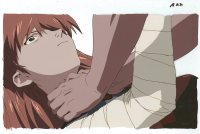
This very common misconception was born due to the last scene of End of Evangelion with Asuka and Shinji alone on the beach. Asuka's arm is bandaged (like Rei's in Episode 01) and her eyes appear to be brown (like Misato's), particularly in older Western releases. This leads some people to speculate that Asuka is really a combination of all three girls, and therefore Shinji's "dream girl" but this notion is absolutely false. The bandaged arm is due to her battle trauma in Eva-02 earlier in End of Evangelion (when a replica lance splits Eva-02's right arm completely). Her eyes are still blue, merely tinted due to the hue of the scene occurring at night.
Before Instrumentality ends, Rei tells Shinji "If you wish once more for the existence of others, the barriers of the heart will separate everyone once more..." while Kaworu asks "Is it okay for the A.T. Fields to hurt you and others once more?", indicating that the A.T. Fields have separated everyone from each other.
The Adam & Eve Scenario (or, Nobody Else is Coming Back)
Considering that themes of Genesis pop up all over NGE, the final scene of End of Evangelion leads many to assume that Shinji and Asuka are the new Adam and Eve, left alone to re-populate the world. But this theory is possibly false if we are to believe Rei and Yui when, during the dissolution of Instrumentality, Rei states, "Anyone can return to human form as long as they can imagine themselves in their own heart.", alongside Yui's reassurance: "All living things have the ability to return to their original form... and the heart to go on living.". This means that other humans are able to return as well should they make the choice to, but it is also perfectly possible for nobody else, or even for very few people to come back. Regardless, Asuka and Shinji will have to learn to deal with one another for at least some time.
Asuka is pregnant
This rumour is linked to the previous one. Usually the idea is that Asuka got pregnant either due to her brief metaphysical sex scene with Shinji shown during pre-3I Instrumentality, or somehow as a "gift" by Rei/Lilith in order to give a headstart to the repopulation of Earth. It can also be theorized as being a result of Shinji "willing" her to return, as mentioned below.
A big reason for the popularity of this theory is that it was supported by the ADV English voice actors of Asuka and/or Rei back in the 90s, along with other theories like the "combination girl", and a similarly unsubstantiated claim that "Anno confirmed this". The claim that Asuka's final "kimochi warui" line can be used to express morning sickness on Asuka's part isn't necessarily wrong, but there is no other evidence to support this theory. Because other people can come back, it's not required for Asuka to be pregnant in order to preserve humanity. However, just like the Adam and Eve scenario itself, this can't be definitely disproven, nor does it preclude the possibility of Asuka getting pregnant later.
Asuka was brought back by Shinji
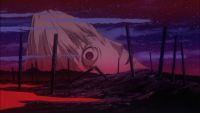
Main article: Theory and Analysis:Final Scene in End of Evangelion
It is often assumed that Asuka was brought back to life either by Shinji willing it or Rei/Lilith/Yui somehow deciding to return her to the real world in order to provide Shinji with companionship, as in the Adam & Eve scenario. However, there is plenty of evidence indicating that Asuka, in fact, has decided to return from Instrumentality herself, out of her own free will: she goes to the beach (instead of just materializing by his side), and finds the markers Shinji set in her and other characters' memory. Immediately she assumes Shinji thinks she's dead, so she kicks the marker with her name to signify she's alive, as well as her will to live. She finds Shinji asleep on the ground. Instead of waking him up, kicking him or yelling at him, she decides to sit and sleep by his side.
Asuka did not have the strength to resist Shinji
Another interpretation is that Asuka did not punch or otherwise react aggressively to him choking her again was that she simply did not have the energy to resist. Not only is this disproven by above evidence, Megumi Ogata also details this mirrors the experience of a female acquaintance of Anno's, and this is a deliberate choice on Asuka's part. This is a summary of her interview from Evangelion Forever:
According to Megumi Ogata, Shinji's voice actress, the scene itself was modeled on a experience of a female friend of Anno's. This friend got into an argument with her boyfriend, and at some point he choker her in rage. Instead of reacting violently, this friend felt no fear, hatred or even a need for survivl, but rather a desire to caress him tenderly. In response, her boyfriend lost her grip. However, Anno's friend instead grew cold, and muttered Asuka's line from the EoE draft almost verbatim. Ogata believes this scene was how Anno wanted to "convey different ways how to bring feelings of love to a conclusion that exist in reality. You are you, I am I". Naturally, this reflects on the films of individuality and the duality of reaching out to others present in Eva.
Anno also guided Ogata to treat OMF partly as a separate story: "as something that just exists. As if everything that happened before in the movie is merely a dream that never happened. It is its own narrative unity, something that can fundamentally be taken away from its context in the movie and still be interpreted as a dramatic whole. It is and is not the final scene of EoE."
Furthermore, Ogata asked Anno to help her understand what Anno wanted to convey through the scene and how Shinji is supposed to act. Hearing this, Anno first stands silent and confused for a moment. Then he firmly wraps his arms around himself and hugs himself. This is on the "purpose" of what he is trying to express. As for how Ogata should play Shinji Anno asks her to not play Shinji: " "For this scene alone, I want Ogata to take on and express my feelings rather than Shinji's" - 『井手功二のエヴァンゲリオンフォーエヴァー』(アミューズブックス)
Asuka and/or Shinji attempted to commit suicide
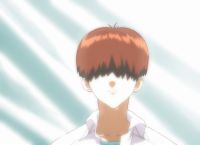
Common theories due to the lack of clear detail on the scenes in Episode 24 and Episode 26', in which Asuka supposedly cut her wrists in a bathtub, and Shinji supposedly tried to drown himself in the lake. In fact, in both instances, several pieces of evidence and thematic considerations invalidate this. In both cases, Asuka and Shinji lost their will to live, but did not have the will to kill themselves either. In fact, both scenes parallel each other and other instances. See the following articles:
Theory and Analysis:Shinji and the Lake
Theory and Analysis:Asuka and the Bathtub
Netflix made the new Evangelion translation, and other localization myths
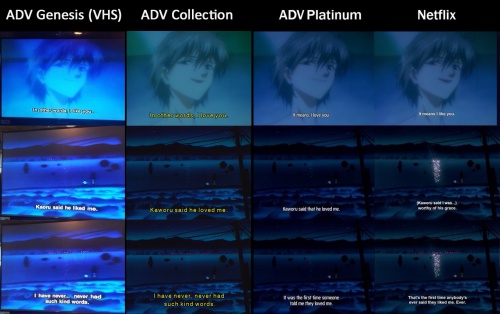
As explained in the first session of Theory and Analysis:Kaworu's lines in Episode 24, Netflix had no hand in the localization of Evangelion, and it was in fact made by Studio Khara's own in-house translator, Dan Kanemitsu. This was the first translation handled directly by the makers of the show, something that did not happen with the older ADV translations of Evangelion, which had multiple problems - it's even sometimes claimed Anno himself oversaw or even made the old translations and Gainax/Khara isn't involved with the new one, when the opposite is true. Some myths are also perpetrated by fans who have watched the show using old fan-made subtitles, often without their knowledge, like the supposedly replaced "worthy of love" line, which was never present in any official Eglish release - it was previously "sympathy" and "regard".
Anno's involvement with the Neon Genesis Evangelion 2 videogame
As with other myths involving derivative material, this one claims Anno was heavily involved or even wrote part of the Neon Genesis Evangelion 2 video game, which provides the source for the Classified Information material. His only confirmed involvement is being interviewed by the makers of the game, along with other Gainax staff, which helped them with worldbuilding and writing the CI files themselves. They also claim the scenarios present within the game itself are simply made for it and can be disconsidered regarding their canonicity. In a production log, they explain they wanted to create their own "world of Evangelion"[4]. This is also expressed in their effort to create an "autonomous" simulation and characters. This allows the player to create numerous scenarios for characters, battles, and relationships.
Kaworu penetrated Shinji's A.T. Field as his transition guide
Main article: Theory and Analysis:Motherly and Cross Symbolism in EoE
A misconception born out of some easily missed details. After emerging in Eva-01 and seeing Asuka's dead Eva, Shinji panics, not only because of the shock of losing yet another person he cared about, but his last avenue of escape is seemingly gone. To add insult to injury, Rei-Lilith starts gruesomely mutating, and Shinji even sees a giant Rei's mangled head shape-shifting before his eyes. This is enough to drive Shinji further into despair and he enters an absolutely frenzy. By this point he could have conceivably become a danger to the process of starting Third Impact proper, so this calls for some action on Lilith's part. As Shinji is already disturbed and alienated by others, and has just lost what he saw as a last avenue of escape in Asuka (though she returns to being that soon after), Lilith morphs into Kaworu. This calms Shinji down, and Lilith uses the opportunity for the Lance of Longinus to penetrate Unit 01's core and transform Unit 01 into the Tree of Life, as the SEELE councilmen ritually chant in triumph.
This has sometimes been used as evidence that Shinji actively wished for Kaworu in this scene and that he was the motivation for Shinji to enter Instrumentality by being the person he wanted, similarly to what happened for Hyuga with Misato. However, Shinji's scene simply does not play out like that. In fact, the storyboards and script make it clear that it is not Shinji's A.T. Field that is being penetrated, but rather Unit 01's. This is paired with Eva 01 audibly moaning, voiced by Megumi Hayashibara (Yui). After this, Shinji is still visibly present and physically integral. Fuyutsuki also adds that Unit 01 now possess both the Fruit of Life and the Fruit of Knowledge, alluded to by Makoto mentioning the AT Field shifting into "Pattern Red", yet another element associated with the Angels and Evas, but not the pilots. Fuyutsuki then explains that it's now in Shinji's hands, further emphasizing that Shinji hasn't yet entered Instrumentality.
Immediately afterwards, Yui in fact explains that "this Rei represents your very hopes and dreams", and as she says that, Lilith morphs back into Rei. Rei then asks Shinji "what do you wish for", and then Shinji has a vision of a woman's breasts being clutched, then the screen has a "bubbly" effect and turns orange, much like LCL. This is when Shinji enters Instrumentality. Storyboards identify this merely as a "woman's", but the vision resembles Asuka or Misato. Regardless, this scene is not at all about Kaworu or Asuka but rather the overwhelming Freudian/Jungian "return to the womb" themes, to which Kaworu, but also Misato, Rei and obviously Yui have a thematic connection to, and Kaworu's brief appearance is overshadowed by the larger context of the scene both before he appears and after Lilith reverts back to Rei. Additionally, Kaworu is still present in the "back half" of Lilith, suggesting his soul was absorbed (presumably harvested or by Gendo through his Adam implant, which was then absorbed by Rei), which makes this further different from the following Rei apparitions as it is not Lilith having the appearance of that person's wish, but instead Adam as part of herself. In fact, Lilith (Rei) and Adam (Kaworu) fusing was a necessary part of enacting Third Impact, hence why Gendo had the weakened Adam embryo in his hand in the first place, with Kaworu's soul having presumably returned there, being a portion of Adam's own soul, not unlike what happened with other portions of Lilith's soul, or Kyoko's. Thus, we can safely say it's not Kaworu manifesting as a transition guide like for other characters, but instead Kaworu/Adam himself, already fused with Lilith.
In EoE, Instrumentally is focused on his return to the womb and his anxieties surrounding the women in his life, mainly Asuka, whose affection he desperately, and selfishly, seeks immediately after entering Instrumentality. Kaworu is completely absent from Instrumentality afterwards despite there being every reason for Shinji to go after him if he wanted to, only showing up at the very end in which he completes Rei's lines as Adam. Additionally, Rei and Kaworu later refer to themselves in the plural to Shinji inside Instrumentality, regarding humanity collectively. This simply doesn't match with the idea of Shinji as deeply wanting him or having been brought there by accepting or giving into him in the first place. Far from it, Shinji is still distressed and is still seeking complementation. Retroactively, Kaworu is briefly only mentioned in the series' Instrumentality in the context of Shinji feeling guilty over killing someone he saw as human, and thinking that maybe he did not really kill him would take a weight off Shinji's shoulders.
Even when Shinji says "you were there all along" he is in fact echoing what Asuka says earlier in the movie when she finds out Kyoko is residing inside Unit-02, and Kaworu calls Shinji when he is looking at Misato's cross, his last memory of yet another maternal figure. Both Asuka and Shinji quickly revert to a status of childlike glee. Shinji is looking for an escape, a mother's embrace to let him run away from the harsh reality. Interestingly, an earlier draft of EoE had this made far clearer, emphasizing further (to Gendo) that Adam has been fused into Lilith, as well as her trying to penetrate Unit 01's core. Additionally, Rei herself said Kaworu's line and only briefly morphed into Kaworu afterwards. Of course, except (partly) for the line, this is all still the case in the final version of the movie, but it's less clear, much like how the ending featured in that draft is almost identical but gives far more details compared to the final one.
Misatributed or mistranslated sources
As discussed on What Is Canon?, there are several claims of "official Evangelion material" or statements that are anything but. Often, these are made by third parties, fanmade, or represent non-canon material, like individual routes for video game spin-offs. These are some of the most commonly cited ones and a counterexample, where applicable.
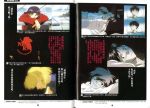 |
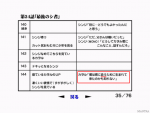 |
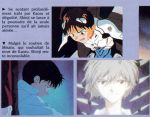 |
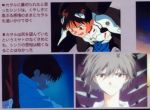 It's also the same text present in the D&R program book. |
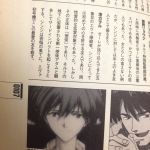 |
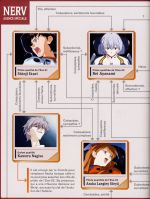 |
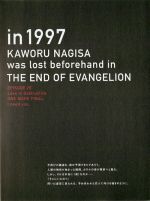 |
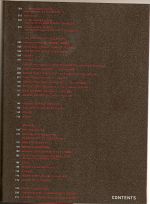 |
Anno forced Megumi Ogata to choke Yuko Miyamura
Another rumour surrounding the production of EoE, surrounding one of the more violent aspects of Evangelion production. Anno had difficulty in finishing this scene, and in order to get the most realistic performance, Megumi Ogata (Shinji's seiyuu) actually choked Yuko Miyamura (Asuka's). Some say this was Anno forcing them, however it was clearly consensual. The sources don't clarify whose idea it was, however.
MO: I'm delighted that you think I sounded natural as if I was doing ad-libs. I don't remember doing anything experimental. There was a time when I actually pushed Yuko Miyamura to the floor to strangle her during the last scene of the "Evangelion" movie in which Shinji strangles Asuka. I couldn't act very well in playing that scene. I was so agitated that I strangled her too hard, making it impossible for her to say her lines for a while. Of course, I apologized to her for doing that. I almost killed her. - Statements by Evangelion Staff - Megumi Ogata on fandom and choking Yuko Miyamura
CF: Did Megumi Ogata (Shinji) really strangle you while recording the voices for the End Of Evangelion to get a realistic performance?
YM: Yes, she did. I tried many times to make it sound like I was being strangled, but I couldn’t get it right. So, Megumi Ogata helped me make realistic sounds by actually strangling me. She’s nice isn’t she!? - Gold Coast Film Festival 2010
Ogata also says in another interview (Evangelion Forever) that the scene was based on the experience of a female acquiantance of Anno's.
